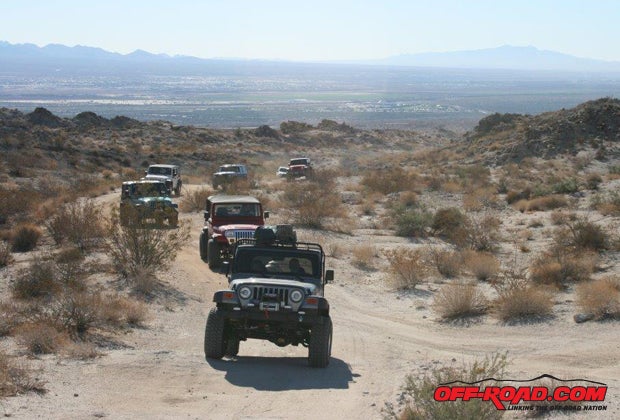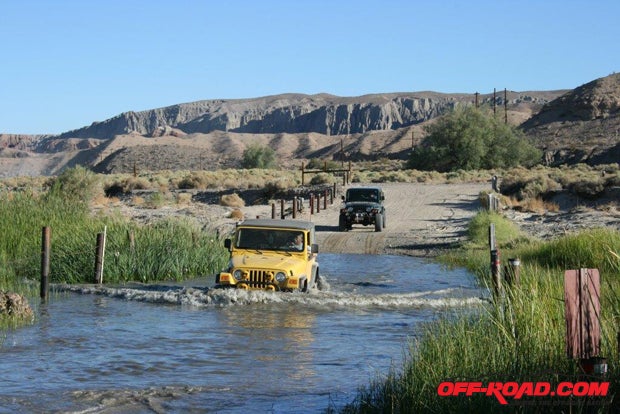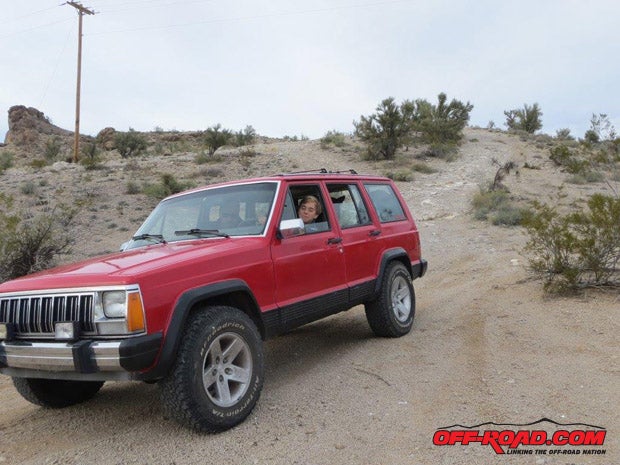
In your Jeep Creep questions, please list your first and last names, your hometown, and your state/province/country, so that we can publish that information here. If you don’t provide this information, we may not be able to publish your question and answer. Don’t forget to be as complete as possible with the description of your Jeep and its problems, too. Send your Jeep questions to editor@off-road.com, Attn: Jeep Creep.
PREVIOUS JEEP CREEP COLUMNS
January 2015
December 2014
November 2014
Two Jeep recalls from NHTSA this month
15V-041--Chrysler is recalling certain model year 2014-2015 Jeep Cherokee vehicles manufactured January 1, 2013, to November 19, 2014. The affected vehicles may experience unintended side curtain and seat air bag deployment during vehicle operation. If the air bags deploy unexpectedly during vehicle operation, it can increase the risk of personal injury and increase the risk of a crash. Chrysler will notify owners, and dealers will re-flash the occupant restraint control module software, free of charge. The recall is expected to begin on March 26, 2015. Owners may contact Chrysler customer service at (800) 853-1403. Chrysler’s number for this recall is R05.
15V-046--Chrysler is recalling certain model year 2002-2003 Jeep Liberty vehicles manufactured January 9, 2001, to March 28, 2003, 2002-2004 Jeep Cherokee vehicles manufactured February 13, 2001, to May 23, 2003, and 2003-2004 Dodge Viper vehicles manufactured November 1, 2001, to June 30, 2004. Due to electrical noise beyond the tolerance of the air bag electronic control module (ECM), a component in the ECM may fail, causing the front air bags, side air bags, and/or seatbelt pretensioners to deploy inadvertently while the vehicle is being operated. Inadvertent deployment of the air bags may increase the risk of injury and the possibility of a vehicle crash. Chrysler dealers will replace the air bag control module and front and/or side impact sensors as required, free of charge. These parts are not currently available, however, an interim repair is available free of charge that reduces the risk of an inadvertent deployment. This recall remedy was applied during earlier recall campaigns of these vehicles under safety recalls 12V527 and 13V040. All owners that have not had the recall repair performed under safety recalls 12V527 or 13V040 are strongly encouraged to have it performed and not wait for the final remedy to be deployed to the field. The replacement ECM parts needed for the final remedy are not expected to be available until the latter part of 2015. Owners will be mailed an interim notification in late March 2015 and will be mailed a follow up notification when new air bag control modules are available. Owners may contact Chrysler customer service at (800) 853-1403. Chrysler’s number for this recall is R06.
‘75 CJ5
I have a 1975 CJ-5 that has 36,000 actual one-owner miles (I bought it new). It’s been playing “Sleeping Beauty” under an elm tree in my backyard since about ‘01. I am thinking about swapping out the transmission and transfer case (or the entire drivetrain) for something that’s a later vintage. I would like to stay with a 258-CID type block, but have an automatic tranny, and modern transfer case (preferably selectable for 2WD or 4WD), and disc brakes. I can keep the stock axles, as they have automatic hubs and 3.73 gears. I’m also interested in an OBDII unit with fuel injection for reliability. So an engine (or parts) swap could come along with the project. Currently, I have a 258 with a Holley 750, big valves, cam and headers, that’s a little too ‘torquey’ for the street. I’d keep my engine, but I want to be able to switch back to the current drivetrain set up if I decide to. This car is a ‘survivor’, never been repainted, only mods were as listed above and I installed a GMC truck type four-speed driven by an 11” clutch/pressure plate from a 1-ton GMC wrecker, due to input shaft problems. Oh yes, it has Mopar high back bucket seats, roll cage, and five-point harnesses for when I was racing it. What ‘donor’ vehicle would you recommend I search for to make this a bolt-in swap? I figure I will have to get new driveshafts built, so that’s not a problem. I’m thinking Liberty, Patriot, Cherokee, or Wagoneer (year and model?). I don’t know the new designations for Jeeps; all these XJ, TJ, JK, etc. mean, so please be kind and use names. I’m turning 68 in January, and have had two heart attacks, a broken back, and hip replacement; but I still want my old CJ to putt around in (now that it is an antique) in my retirement years. It could become a daily driver if I can get it working to suit me.
Rick Baker
Haysville, KS
Before I get into what vehicle would make a good donor vehicle, I’ll explain the various Jeep letter designations.
Here’s a breakdown:
XJ = Cherokees, 1984-2001
TJ = Wranglers, 1997-2006
LJ = longer wheelbase Wrangler TJ, 2004-2006
JK = Wranglers (two- and four-door models), 2007-current
I suggest for a donor Jeep, use a 1997 or newer XJ to get the 4.0L engine with electronic fuel injection (EFI), four-speed automatic transmission (with OD), and Dana 300 transfer case (or you could use an Advance Adapters Atlas 2 transfer case). You’ll need a super-short rear driveshaft with a very short slip-yoke eliminator kit on the NP231. You’ll have to change to an electronic speedometer. I’d also suggest that you replace the automatic hubs with a fresh set of Superwinch or Warn selectable hubs. The automatics don’t work in reverse, unless you actually engage them. And with an overdrive transmission you could install deeper differential gears such as 4.11:1 or 4.27:1 (which is what I had in my ‘74 CJ5).
Towing a 2014 Jeep Wrangler with Four Down
I plan to tow my 2014 Wrangler Sport four down behind my 2012 Thor Tuscany motorhome. I’ve been towing Jeeps behind motorhomes for years without disconnecting the batteries. Now my owner’s manual says that the negative battery cable must be removed from the battery before the Jeep can be towed. My vehicle satisfies all other criteria--i.e. both the tranny and the transfer case can be put in neutral. Now the rub: I have taken the truck into the two major facilities in Carson City, NV, that do work on both coaches and towing systems and asked if they thought disconnecting the negative battery cable was (1) necessary and (2) doable by installing a simple “on-off” switch for the battery. Their answers were an emphatic “NO!” In fact, both centers stated that by disconnecting the negative cable I would lose all stored data in the on-board computer system and that neither facility had ever heard of having to disconnect the negative battery cable just to operate a towed vehicle braking system. Both centers flatly refused to install an on-off switch and one center stated that whomever told me to disconnect the negative cable before towing needs to tell everybody just exactly “why.”
Rudy Hindelang
Dayton, NV
While I haven’t read the owner’s manual for the 2014 Wrangler Sport, I have read the owner’s manual for the 2007 Jeep Rubicon Unlimited, which I bought new and flat-towed behind several different motorhomes. I can’t understand why the techs at the RV shop in Carson City said they’ve never heard of disconnecting the battery while flat towing. Chrysler did it across its entire brand (Jeep, Dodge, Chrysler, Ram, etc.) in the middle of the last decade (i.e., Jeep in ‘07; the rest of the approved towables within a model year either way). The reason Chrysler did it—I assume—was to save a buck or two on each unit by eliminating the ignition position that unlocked the steering wheel without turning on the dash lights or any accessory. Since the dash lights, computer, and a few other minor electrical parasites were now turned on while the steering wheel is unlocked, the negative battery cable was to be disconnected while towing. I avoided doing this in two ways: I don’t like driving more than three to four hours—or less—without a break, so whenever I stopped for a driving break I’d start the Jeep’s engine and let it idle to recharge the battery during the break. I did this with a “dumb” key—which didn’t have an imbedded chip—because the computer wouldn’t allow the engine to do anything but idle with the dumb key (as soon as it was shifted into the gear the engine would stop) and this was also the key I used while flat towing so the Jeep was much more difficult to steal with it in the ignition. The other way I kept the Jeep’s battery charged while towing with my own coach was a double-fused “hot” line from the coach’s battery to the Jeep’s battery. There are a few kits available to manually disconnect the battery, do a Google search for them. Many racers use a master switch—either with a key or just a switch—to disconnect the battery (check with Summit Racing).

GC V8 into YJ
I have a question about swapping a 2000 Grand Cherokee 4.7 V8 engine into my 1994 YJ. Currently the YJ is a 4 cylinder and I am looking to swap it for something with more power. I have found a donor Cherokee for $500. Before I buy it I’m wondering is it worth it? Will the engine, tranny, and transfer case swap in smoothly or with some adaptation? Any specifics I would need to know about the idea or anything at all? Any information would be great.
Bill Sanders
Casa Grande, AZ
You won’t be able to use the transfer case, Bill, because of driveshaft alignment. However, the engine and tranny will slip in with some typical modifications. Contact Advance Adapters (www.advanceadapters.com), as they can provide all the information and products you’ll need to do a first-rate job.
Two-Wheel Drive?
I have a ‘97 Jeep Wrangler with the 2.5L four banger. When I engage the 4-wheel drive low only one of the front and one of the rear tires are powered. But my father’s ‘99 Wrangler powers all four. Both Jeeps are stock. Is something broken on mine or do they have different drive options? And how can I fix this? Any info would be great!
Jon Jay
Chester, NH
Jon, I just bought a “new” 2005 Rubicon Unlimited from near you in Manchester. Anyway, I think your dad’s Jeep may have limited slip in the differentials (or your dad may have installed lockers without telling you?). Yours is typical of a Jeep with open differentials. To check to make sure you don’t have a broken axle, however, jack up each axle separately and safely until both tires are off the ground. By hand, spin one tire. If the differential and axles are normal and not damaged in any way, the tire on the opposite side will spin in the opposite direction (if the axle is broken, it may not move). You can test this theory with your dad’s Jeep. Lift both tires off the ground. If it has a locker or limited slip, when you spin one tire by hand, the opposite tire will spin in the same direction—not in the opposite direction as it will with an open differential.

Grinding Clutch
I have a ‘95 Cherokee 4.0L; manual tranny (AX-15). On the highway in fifth gear only it makes a sort of grinding sound. I don’t know where the sound is coming from, but it sounds like in the front of the transmission somewhere. When I push the clutch in; the grinding noise stops. What could it be?
Roland Lerner
Farmington, NM
I think it’s the throw-out bearing on the clutch linkage. The throw out, or clutch release, bearing depresses the pressure plate fingers to release the clutch (push the pressure plate away from the flywheel). It contains a bearing that spins along with the spinning pressure plate when the clutch pedal is depressed. If this bearing is worn, a squealing or growling noise will be heard when the clutch is depressed. If it makes a similar noise when the transmission is in neutral and the clutch is out, it’s definitely the throw-out bearing.
Wagoneer Lift
My dad gave me a ‘78 Wagoneer with a 401-CID V8 and Quadratrac. He got it new in ‘78 and it is completely bone stock. I am doing a few upgrades to it (new carb and intake) and I would like to put a lift on it. What would you recommend for a lift? I’m thinking 4 inches.
Mathew Periwinkle
Canby, OR
With 4 inches you should be able to run 32- or 33-inch tires. It’s a good choice. Just make sure you pick a kit from a reputable manufacturer such as Pro Comp, Skyjacker, Rancho or other established companies. If a kit isn’t available because of the Waggy’s age, a reputable spring rebuilder can re-arch the existing leaf springs. You’ll have to do some research on finding replacement shock absorbers. A good customer service person from one of the big kit manufacturers or Fox Shox should be able to help you with matching the shocks to your Wagoneer.
More Power
I have a 1994 Wrangler that I’m trying to put a 1995 Cherokee motor into. How do I change the fan and belt to make it work?
Al Dreyer
Carlisle, OH
What engine to what engine, Al? You need to be more specific. In which direction are you going: four-cylinder to six-cylinder; or 6 to 6; or 6 to 4? If you’re going six to six, use the water pump and the power steering pump from the Wrangler – the fan will then work. If you’re going four to six, or six to four, it’s time for you to visit the salvage yard to find the parts needed—you’ll have to mix and match so buy one of everything.
No Taillights
I have a 1991 Jeep Cherokee sport 4.0 HO and I have no running rear taillights. I replaced the fuse for the cigarette lighter and now the when I go to use my headlights I have no running rear lights. My brake lights and turn signals work, I just have no rear running lights, license plate light or dash lights. The PARK LGT fuse keeps burning out. The OB1 error code reads 36; Air switch solenoid circuit. I am unable to locate any information regarding this in my repair manual. Any advice?
Heidi Saito
Sweet Home, Oregon
Good information, Heidi, you’ve been very clear with your problem. The fuse you’ve been replacing is used with both taillights and dash lights so that you’ll be instantly aware when you lose your taillights. The wiring circuit for the running/taillights is compromised. Which means it’s shorted out. At some point along its path the wire’s insulation is worn and the wire is contacting metal. The most common spot is between the taillights along the rear end of the Jeep or going into a trailer plug. What usually happens is the wire gets caught by brush, a rock, or debris when you’re out on the trail and is pulled into a sharp piece of metal and gets cut. The other method is caused by vibration over time. Carefully examine the wire between the taillights—which is the easiest and quickest—and the wiring going into the trailer plug (if you have one). To do this, use a circuit tester and discover which wires go to which lights by turning them on one by one and identifying them with the circuit tester—the black wire is ground and the colored wire without power is the taillight circuit. If you don’t find the faulty circuit at the back of the Cherokee, you’ll need a shop manual with wiring diagrams to identify the color-coded circuits in the front of the vehicle. Take your time and carefully check the entire length of wiring loom to each running light, each parking light, and each taillight.
I have a request of all the readers out there. Send us your questions. For some reason the questions have fallen off, and I know we haven’t answered all your Jeep technical questions. There are no dumb questions; only unasked questions. Send them in and try to stump us.—Jim Brightly
As usual, each month, I’m shouting out a huge THANK YOU to Paul Schupp at Rock Lizard 4x4 in Kingman, Arizona, for his invaluable assistance in answering many of the Jeep Creep questions.
Send your Jeep questions to editor@off-road.com, Attn: Jeep Creep.
PREVIOUS JEEP CREEP COLUMNS
January 2015
December 2014
November 2014


 Your Privacy Choices
Your Privacy Choices